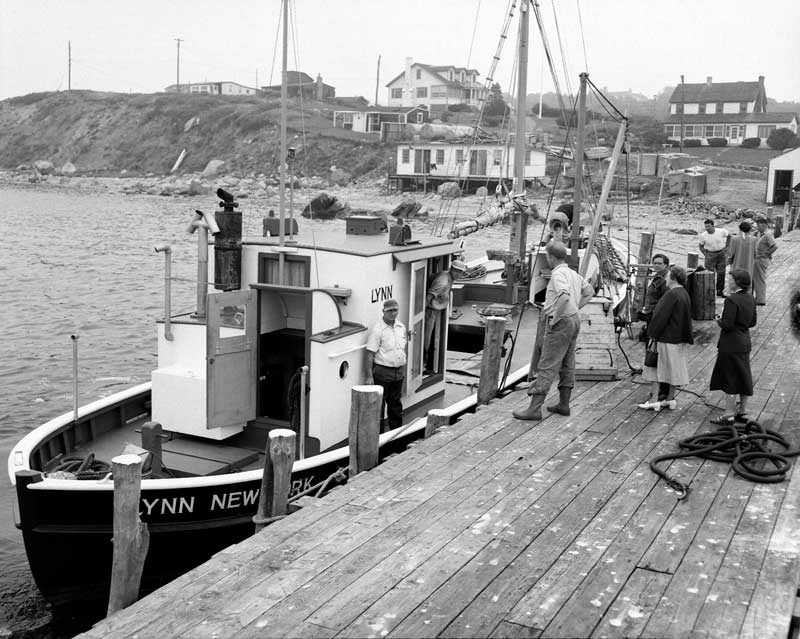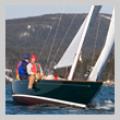When Lynn Lugged the Lobsters
Photos courtesy the Duryea family
 Lynn launches at the original Webber’s Cove Boatyard, East Blue Hill, Maine, April 22, 1948.
Lynn launches at the original Webber’s Cove Boatyard, East Blue Hill, Maine, April 22, 1948.
Thinking big after he returned to his hometown of Montauk, New York, back from being one of the youngest pilots in the Pacific theater in World War II, my father, Perry B. Duryea Jr., was determined to build a large-scale wholesale operation, primarily selling lobsters. This was an expansion of the seafood business his father, Perry Sr., had operated on Fort Pond Bay after moving to Montauk following World War I.
During the war, Perry Jr. had flown amphibious PB2Y Coronados to drop off supplies and collect the wounded on islands in the South Pacific. He was used to the rigors of the sea and ready for the challenges that lay ahead as he built up a three-vessel fleet of transport boats to feed the needs of his growing business.
Sustaining a large wholesale operation meant sourcing lobsters much farther afield than the waters off Montauk. My father made several exploratory trips to Maine, the Canadian Maritimes, and as far away as Newfoundland; and he determined that lobsters could be safely moved from north to south, even with the changes in water temperature, if the right sort of transport vessel could be found. His solutions were two-fold and evolved as he grew the business.
 The Lynn and Perry B. leaving Montauk, New York for Maine,1954.
The Lynn and Perry B. leaving Montauk, New York for Maine,1954.
Working with Maurice “Cy” Cousins of Webber’s Cove Boatyard in East Blue Hill, my father commissioned the 65-foot Lynn. The boat was named after me and christened when I was a year old. I’ve been told she was the last wet-well lobster smack built in the United States.
Wet-well smacks, once common, had become more or less obsolete. A wet-well boat (also known as a live-well boat) had holds amidships with holes that allowed fresh seawater to circulate when the smack was in motion, keeping the lobsters alive. Once the Lynn was loaded, she had to move.
 Duryea’s Lobster Deck circa 2014.
Duryea’s Lobster Deck circa 2014.
By the late 1940s, my father was transporting lobsters from Deer Isle-Stonington, Clark’s Harbour on Cape Sable Island, and Arichat, Nova Scotia. He subsequently purchased property in both Clark’s Harbour and Stonington and established a new company, Lobster Transport of Maine Inc.
To keep up with the growing business, he soon put two more boats into service. These were both converted World War II sub-chasers. First came a 110-foot boat, built in Holland, Michigan, which he had towed by the Lynn to Webber’s Cove, where it was to be outfitted as a transport boat and renamed the Perry B. My father first saw the decommissioned ship in the Brooklyn Navy Yard, and had her armor plate removed for a trial run. Because the Perry B. was a wooden vessel, there was concern that she would break apart due to excessive speed without the armor; subsequently ballast comprised of Maine granite blocks was placed in the bow and stern for stability and to moderate her overall speed.
 A painting of the Perry B. by George W. Torrey Jr., 1956. Capt. George ran both vessels.
A painting of the Perry B. by George W. Torrey Jr., 1956. Capt. George ran both vessels.
Next, my father added the Lynn II to the fleet. She was not quite as long or as graceful as the Perry B. These transport boats were equipped with tanks, through which salt water could be circulated by a system of pumps and pipes. In this way, lobsters could be lowered into the holds in the tanks and then the lobsters and tanks could be removed again once they reached Montauk.
Loading the original Lynn, which became known informally as the “little Lynn” was hard work: Lobsters were tossed into the holds by hand; once in Montauk they were bailed out with large wire or net baskets. Both the loading and unloading had to be interrupted so that the Lynn could move to circulate water in the well. This process, and the fact that the lobsters could be battered in the holds in heavy seas, meant there was some loss during transit.
Eventually, the Lynn’s seatime was scaled back, and she was used in spring, summer and fall runs only. She ultimately was sold to a fisherman in New Bedford, Massachusetts, who “dried her out” and turned her into a dragger. Tragically, the Lynn was lost in a winter storm, along with her captain and two crew members.
What happened that night of Jan. 29, 1964, remains a mystery. There was a Coast Guard investigation, with officials reporting that, “She remains missing without a trace and recommended that the case be closed.” They added, “While weather conditions were without doubt strenuous and dangerous, the fact that five other vessels were faced with the same, and were able to contain the hazards and successfully come through, casts some doubt on the adequacy of security measures taken on the Lynn, the seaworthiness of the vessel, and her equipment.”
 Unloading the Lynn at Duryea’s on Fort Pond Bay in Montauk, in the late 1940s. Capt. George Torrey is leaning out of the pilot house and Perry B. Duryea Jr. is on the dock, with his hands on hips.
Unloading the Lynn at Duryea’s on Fort Pond Bay in Montauk, in the late 1940s. Capt. George Torrey is leaning out of the pilot house and Perry B. Duryea Jr. is on the dock, with his hands on hips.
Some have suggested that the Lynn simply wasn’t as seaworthy as a dried-out dragger as she was as a wet-well smack; the refit changed her sailing qualities. An informative article about the Lynn, by Vernal Hutchinson in the Aug. 9, 1973, Ellsworth American, has provided me with detailed information about my namesake. Hutchinson described a trip from Clark’s Harbour to Montauk, during which the Lynn encountered heavy seas and gale winds. Radio contact was lost due to a blown fuse and there was no spare radio. Many thought the smack and her crew were lost, as larger ships were in distress during the blow. Gertrude, the wife of the captain at the time, Maurice Eaton, was notified. When she broke the news to the captain’s father, Leslie Hutchinson, a veteran smack man, he said “Lynn’s alright wherever she is.”
And she was. The Lynn turned up, “to the surprise of all except old-time smack men,” Vernal Hutchinson wrote.
 Launch day of the Lynn on April 22, 1948 with Perry B. Duryea Sr. standing on the right.
In the late 1950s and early ’60s, it was not unusual for a million pounds of lobsters or more to be transported from Maine and Canada to Montauk each year. At the busiest times of the year, two boats would arrive each week, the Lynn, with a capacity of 15,000 pounds or better, and the Perry B. carrying 25,000 pounds. The seafood business was different, and lobsters were cheaper then; when my father first started buying lobsters in Nova Scotia he was paying 25 cents a pound and selling them for 69 cents a pound to Long Islanders. My brother, Perry “Chip” Duryea III, joined the business full-time in 1974, although he recalls earning a quarter an hour working in the summers when he was 12 years old!
Launch day of the Lynn on April 22, 1948 with Perry B. Duryea Sr. standing on the right.
In the late 1950s and early ’60s, it was not unusual for a million pounds of lobsters or more to be transported from Maine and Canada to Montauk each year. At the busiest times of the year, two boats would arrive each week, the Lynn, with a capacity of 15,000 pounds or better, and the Perry B. carrying 25,000 pounds. The seafood business was different, and lobsters were cheaper then; when my father first started buying lobsters in Nova Scotia he was paying 25 cents a pound and selling them for 69 cents a pound to Long Islanders. My brother, Perry “Chip” Duryea III, joined the business full-time in 1974, although he recalls earning a quarter an hour working in the summers when he was 12 years old!
Those days and these transport boats are all a thing of the past. From the mid 1970s until the early 2000s, when Lobster Transport of Maine was sold, lobsters traveled exclusively by truck to Montauk. The smack era had sailed its course.
✮
Lynn Duryea moved to Stonington in 1974 and has lived on Deer Isle full or part-time since. She is a sculptor currently working in South Portland and on Deer Isle, inspired by the forms and features of working waterfronts.
Besides details about the Lynn taken from Vernal Hutchinson’s Ellsworth American article, Matt Cousins, the grandson of Maurice “Cy” Cousins and current owner of Webber’s Cove, made available photographs of the boat from his files.
The original drawings and photographs of the Lynn are housed at the Penobscot Marine Museum in Searsport and are available online through the PMM web site.
Information and images can also be found in the Deer Isle-Stonington Historical Society archives.
Related Articles
Share this article:
2023 Maine Boat & Home Show

Join Us for the Maine Boat & Home Show!
Art, Artisans, Food, Fun & Boats, Boats, Boats
August 11 - 13, 2023 | On the waterfront, Rockland, Maine
Click here to pre-order your tickets.
Show is produced by Maine Boats, Homes & Harbors magazine.















